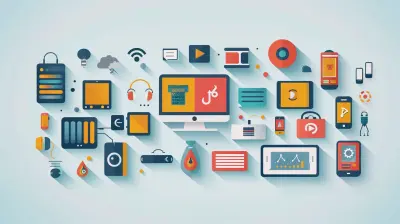The Impact of Edge Computing on Cloud Ecosystems
2 June 2025
Cloud computing has been the backbone of modern digital infrastructure for years, but there's a new player shaking things up—edge computing. Imagine cloud computing as a massive, centralized power plant supplying energy to an entire city, while edge computing is like having solar panels on your rooftop, generating power right where you need it.
So, why does this matter? Because edge computing is redefining how data is processed, stored, and delivered, creating a profound impact on cloud ecosystems. Let’s dive into this exciting technological evolution and see what’s in store! 
🚀 Understanding Edge Computing
Before we jump into its impact, let’s break down what edge computing actually is.What Is Edge Computing?
In simple terms, edge computing moves data processing closer to the source—right at the “edge” of the network. Instead of sending massive amounts of data to a central cloud server, edge computing processes it on nearby devices or local servers.Think of it this way: if cloud computing is like ordering a pizza from a restaurant across town, edge computing is like a pizza oven in your own kitchen—fresh, fast, and piping hot!
Why Is Edge Computing Gaining Traction?
With the rise of IoT (Internet of Things), 5G, and AI-driven applications, the traditional cloud model is starting to feel the strain. Devices are producing mountains of data every second, and sending all of it to the cloud for processing isn’t always practical. Enter edge computing, reducing latency, cutting bandwidth costs, and improving real-time data processing.
🌍 The Impact of Edge Computing on Cloud Ecosystems
Okay, so edge computing sounds cool, but what does it mean for cloud ecosystems? Let’s break it down.1. Reduced Latency & Faster Processing ⏳
One of the biggest drawbacks of traditional cloud computing is latency. Data has to travel from a user’s device to a remote data center, get processed, and then travel back. This delay may not be noticeable for some applications, but for critical systems like autonomous vehicles or smart healthcare devices, even milliseconds matter.Edge computing minimizes latency by processing data closer to the device, ensuring lightning-fast responses. Imagine self-driving cars waiting for cloud servers to tell them when to brake—it’s a disaster waiting to happen!
2. Less Pressure on Cloud Networks 🌐
Cloud ecosystems thrive on vast amounts of data storage and computing power. But here’s the problem—there’s too much data. Bandwidth is expensive, and constantly streaming data to the cloud is inefficient.With edge computing, only the most important or processed data is sent to cloud servers, reducing network congestion. This allows cloud ecosystems to become more efficient and cost-effective instead of drowning in a sea of unnecessary data.
3. Enhanced Security & Privacy 🔒
Nobody likes the idea of their data being vulnerable in faraway data centers. Cloud security is a big concern, and with data breaches on the rise, businesses are looking for safer alternatives.By processing sensitive data locally, edge computing reduces risks. Imagine smart cameras in a factory that analyze footage on-site, instead of sending everything to the cloud. This means even if cloud services are compromised, confidential data remains secure.
4. Better Support for IoT & 5G 📡
IoT devices are everywhere—from smart fridges to connected traffic lights. But here’s the catch—they produce crazy amounts of data. Cloud computing alone simply can’t handle the sheer volume efficiently.Edge computing acts as a middleman, processing data locally before deciding what actually needs to be sent to the cloud. Couple this with 5G’s ultra-fast speeds, and we’ve got a dynamic duo that’s changing the game!
5. Lower Operational Costs 💰
Cloud computing is great, but let’s be honest—it’s expensive. Storing and processing endless streams of data in the cloud racks up serious costs for businesses.Edge computing cuts these costs by reducing unnecessary cloud usage. Companies only send relevant, processed data to the cloud, leading to lower bandwidth expenses and optimized cloud storage costs.
6. New Cloud-Edge Hybrid Models 🏗️
Rather than competing with cloud computing, edge computing is enhancing it. The future isn’t a complete shift away from the cloud but rather a hybrid model, where edge and cloud work hand in hand.Many cloud service providers are already jumping on this trend. Amazon Web Services (AWS), Microsoft Azure, and Google Cloud are integrating edge computing solutions into their ecosystems, ensuring the best of both worlds. 
🔮 The Future of Cloud with Edge Computing
So, where do we go from here? Edge computing is still evolving, but its impact is undeniable. Here’s what we can expect:- More Smart Cities – Edge computing will power connected infrastructure, from traffic management to energy grids.
- Growth in AI & Machine Learning – Devices will process AI algorithms locally, reducing reliance on cloud-based AI models.
- More Efficient Cloud Services – Cloud providers will shift towards cloud-edge hybrid infrastructures for better efficiency.
- Increased Adoption in Healthcare – Real-time patient monitoring without cloud delays will become standard.
If current trends continue, we’re set for a smarter, faster, and more efficient digital world. 
🎯 Final Thoughts
Edge computing isn’t here to replace cloud computing—it’s here to enhance it. By reducing latency, improving security, cutting costs, and optimizing bandwidth, edge computing is making cloud ecosystems leaner, smarter, and more responsive.So, whether you’re using a smart home gadget, relying on real-time AI analytics, or driving an autonomous car—edge computing is working behind the scenes, making everything smoother and faster.
The bottom line? The future of computing isn’t just in the cloud—it’s at the edge.
all images in this post were generated using AI tools
Category:
Cloud ComputingAuthor:

Marcus Gray
Discussion
rate this article
3 comments
Eliza Wade
Oh great, just what we needed—more computing layers to manage! Because who doesn’t love a little extra complexity in their cloud ecosystems? Bring on the edge chaos!
June 9, 2025 at 2:33 AM

Marcus Gray
I understand your concerns! While edge computing adds complexity, it also offers improved performance and reduced latency, ultimately enhancing the user experience. It's about finding the right balance.
Winter Soto
Edge computing significantly enhances cloud ecosystems by reducing latency, improving data processing efficiency, and enabling real-time analytics, ultimately driving innovation across various industries.
June 5, 2025 at 12:02 PM

Marcus Gray
Thank you for your insightful comment! I completely agree that edge computing plays a crucial role in optimizing cloud ecosystems and fostering innovation.
Julia McGlynn
Edge computing revolutionizes cloud ecosystems, powering real-time insights and driving innovation forward!
June 5, 2025 at 2:58 AM

Marcus Gray
Thank you for your insightful comment! I completely agree—edge computing is indeed transforming cloud ecosystems by enabling quicker data processing and fostering innovation.



